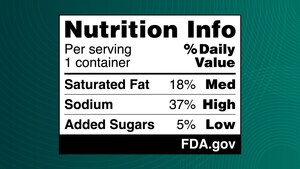SILVER SPRING, Md., Sept. 22, 2021 /PRNewswire/ -- Today, the U.S Food and Drug Administration issued for public comment two draft guidance documents that, if finalized, will help manufacturers of animal cells, tissues, and cell- and tissue-based products (ACTPs) understand current good manufacturing practice requirements (CGMPs) for new animal drugs under the Federal Food, Drug, and Cosmetic Act (FD&C Act). CGMPs help prevent contamination and help ensure ACTP quality. If finalized, the recommendations are intended to support the development of promising and innovative products that can benefit animal health.
"ACTPs have the potential to make significant changes in how we treat diseases and may provide novel therapies for unmet therapeutic needs of animals. We want to support manufacturers in the safe production of these promising products," said Dr. Janet Woodcock, Acting Commissioner of the FDA. "It is important to note that the FDA is not imposing any new requirements on the manufacturers of ACTPs with these new draft guidance documents. These draft guidance documents, if finalized, are intended to assist manufacturers by providing product-specific recommendations that will help developers of these products meet existing FDA manufacturing requirements. Our goal is to help manufacturers be successful in their efforts to develop innovative products that can benefit animal health."
In the draft guidance, ACTPs are defined as products that contain, consist of, or are derived from cells or tissues that are intended for implantation, transplantation, infusion or transfer into an animal recipient. Furthermore, ACTPs refer to products that meet the definition of a new animal drug. In the draft guidance, ACTPs include both cell-based products and animal stem cell-based products. ACTPs are most commonly investigated for regenerative medicine applications because they have the potential to repair diseased or damaged tissues in animals through regeneration and healing. Currently, these products are most commonly investigated and used in companion animals including dogs, cats, and horses; however, ACTPs may be also be developed for use in other species.
All new animal drugs are required to be manufactured in accordance with CGMPs to ensure that such drugs meet the requirements of the FD&C Act for safety, and to have the identity, strength, quality, and purity characteristics which they purport to or are represented to possess. Because the manufacture of ACTPs present unique considerations for complying with CGMPs, the FDA is issuing two draft guidance documents for industry.
The first draft guidance, #253, "Good Manufacturing Practices for Animal Cells, Tissues, and Cell- and Tissue-Based Products" provides manufacturers of ACTPs with recommendations for meeting requirements for CGMPs. It addresses the methods, facilities and controls used for manufacturing ACTPs, including steps in recovery, processing, storage, labeling, packaging and distribution. The draft guidance also addresses methods for preventing contamination and ensuring quality of the ACTP during manufacturing.
The second draft guidance #254, "Donor Eligibility for Animal Cells, Tissues, and Cell- and Tissue-Based Products", if finalized, will assist sponsors, firms or establishments that participate in the manufacture of ACTPs or perform any aspect of the ACTP donor eligibility determination. Selecting appropriate donors is critical to product quality and preventing the transmission of disease.
The concepts and principles in these draft guidance documents are consistent with the FDA's Center for Biologics Evaluation and Research's (CBER's) regulations (21 CFR 1271 subparts C and D) and associated guidance documents for human cells, tissues, and cellular and tissue-based products.
"The FDA is seeking to improve transparency by engaging early in the development process and informing industry of our draft recommendations now, while the industry is still taking shape, as we are receiving applications seeking approval of ACTPs for use in animals," said Dr. Steven Solomon, director of the FDA's Center for Veterinary Medicine. "As part of our commitment to fostering the development of innovative products in the most streamlined and efficient manner possible, we're encouraging the ACTP industry to take advantage of our Veterinary Innovation Program, which is designed to assist product developers generate the appropriate data needed to support a new animal drug application."
The FDA recommends sponsors and manufacturers of ACTPs contact the FDA early and often in the product development process to discuss considerations specific to the manufacture and approval of new animal drug products. The FDA has developed a process for these interactions through participation in its Veterinary Innovation Program, a program available to most ACTPs and aimed at providing greater certainty in the regulatory process, encouraging research and development, and supporting an efficient and predictable pathway to approval for these innovative products.
The FDA is accepting public comments on both draft guidance documents until November 22, 2021 so that we may consider comments before potentially issuing final guidance documents; however, comments on guidance documents are welcome at any time. Later this year, the FDA will also host a webinar to discuss the draft guidance documents for all interested stakeholders. Visit FDA.gov for more information.
Media Contact: Veronika Pfaeffle, 301-310-2576
Consumer Inquiries: 888-723-3366
The FDA, an agency within the U.S. Department of Health and Human Services, protects the public health by assuring the safety, effectiveness, and security of human and veterinary drugs, vaccines and other biological products for human use, and medical devices. The agency also is responsible for the safety and security of our nation's food supply, cosmetics, dietary supplements, products that give off electronic radiation, and for regulating tobacco products.
SOURCE U.S. Food and Drug Administration

Related Links
WANT YOUR COMPANY'S NEWS FEATURED ON PRNEWSWIRE.COM?
Newsrooms &
Influencers
Digital Media
Outlets
Journalists
Opted In






Share this article